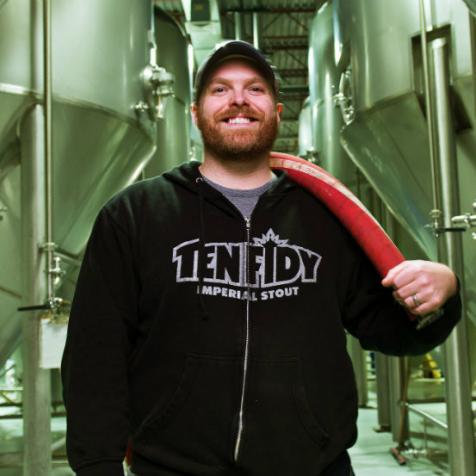
Company Details
Location
Longmont and Lyons, Colorado
Founded
1997
Ownership Type
Private
Employees
100
Products
Beer
With a new Austin facility set to open in the spring, Colorado's second-largest craft brewery plans to increase production more than 26 percent to nearly a quarter-million barrels in 2016.
With a new Austin facility set to open in the spring, Colorado's second-largest craft brewery plans to increase production more than 26 percent to nearly a quarter-million barrels in 2016.
When Tim Matthews, head of brewing operations, started with Oskar Blues in 2008 as a shift brewer, the production team produced 17,000 barrels of beer at a single location. Founder and CEO Dale Katechis had led craft beer's charge into cans four years earlier.
Fast forward to 2016, and the rapidly expanding brewery has set a goal of 243,000 barrels -- that's 26.5 percent more than 2015's 192,000, which ranked no. 24 in the U.S. -- to be brewed in three locations, along with broadening its distribution footprint to include the entire U.S.and parts of Canada, Sweden, Norway, and the United Kingdom.
How is this even possible? The short answer is people. "We have a lot of different people with different skills who know how to collaborate with each other," Matthews explains. "Our organizational structure is lateral and very team-focused. It's the only way we are able to get these kinds of things done."

This includes employees to run the pilot system at the brewery's original location in Lyons, Colorado, now known as The Original Oskar Blues Grill and Brew, as well as a 50-barrel brewhouse at their 100,000-square foot facility in Longmont and another 50-barrel system at the 52,000-square foot facility in Brevard, North Carolina. This April, they'll add yet another team to brew Oskar Blues Brewery favorites such as the bestselling Dale's Pale Ale and Pinner Throwback IPA in a new 50,000-square foot location in Austin, Texas.
Coming on the heels of a 2015 investment from Fireman Capital Partners, the company's decidedly aggressive expansion plan requires calculated decisions to enable efficient utilization of resources. Everyone from the sales department to the production floor has been engaged in ensuring a balance of quality and innovation as the scale increases. "We're very tentative about jumping on bandwagons," Matthews says. "We'll mess around with stuff on our pilot system all the time, but we also receive direction from sales in terms of what might do well in the market."

At present, Matthews and his team are working on a Vienna lager and a Belgian wit. "The Vienna is an amber lager that will feature a lot of layers of malt flavor," he says. "We're making it very light at about 4 percent ABV. The wit is a beer we've actually been brewing in Longmont for a while but have recently manipulated with a new yeast strain."
Though most of their pilot experiments will never see large-scale production, Matthews understands the importance of keeping the brewery's fans excited. "That is why we're expanding our barrel aging program tenfold in 2016," he explains. "We really want to master the bourbon-barrel aged Ten Fidy, and we're going to do about 1,000 barrels of it. We'll be doing some exclusive releases in that vein in the late fall."
Favorite beers: "I admire breweries that have dug into the science of their product," says Matthews. "The leader in that in the craft beer industry has to be Sierra Nevada Brewing Company. I've loved them for years and think their beers are incredible. Firestone Walker Brewing Company does impressive things as well, especially with ingredient innovation."

Challenges: "Quality is for sure our biggest challenge," Matthews says. "We have to make sure that the beer is the best it can be every single time. That's challenging, especially when you're trying to keep up with production demand. Things can sneak by, but you have to figure out how it happened, what you need to change, and how you can get better because of it. And the bigger you get, the more new issues are likely to arise."
Opportunities: New flavor innovation is an area in which Matthews sees a lot of opportunity. "There's a lot of creativity in the industry," he says. "At Oskar Blues, we've recently been digging into the traditional ingredients of malt, hops, yeast and water and trying to find ways to build upon them. We may work with a hop breeder to develop a new type of hops or a maltster to develop new malt flavors. We're also playing with combinations of hops that play nicely with the esters produced by Belgian and saison yeasts. Thanks to microbiology, you can create some interesting flavors."
Diversification is another: Oskar Blues has moved into canned craft coffee with its Hotbox Roasters brand, and it's also selling Crowlers it developed in partnership with Ball to other craft breweries for hand-canning at the taproom.
Needs: "We always need qualified people to fill jobs -- the right people who can help us maintain the advances we've made and even push us to the next level," Matthews says. "You can't do everything yourself; you must bring on people with unique skill sets to help you move forward."

